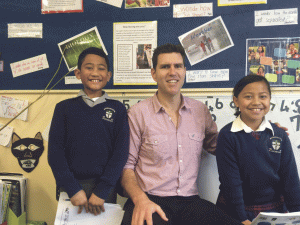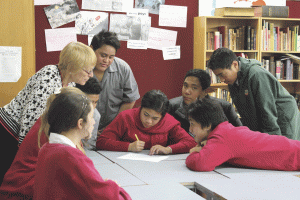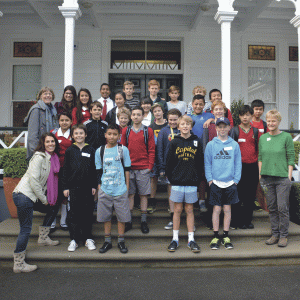December 2015
Profile
‘Mo Te Katoha Nga Mahi’
‘All that is done is done for the good of all’
Porirua was created as a planned city after World War 2. With a rich heritage and a growing multitude of cultures and the city has life of its own, where many are proud to call home. This year, it celebrates 50 years as a city. Stories on this page are from people who live and work in its parishes and schools.
Porirua – ‘rich in everything but money’
Sr Anne Phibbs CSB
On 2 October 2015 Porirua marked the 50th anniversary of its establishment as a city. The well-known psychiatric hospital opened in Porirua in 1887; there were farms and there were seaside homes in Plimmerton and Titahi Bay. But it was during the 1940s that land pressure in the Wellington urban area caused farms to be bought up and state houses built. The first houses followed the natural topography of the land, but in the early 1950s large earthworks began and completely altered the landscape.
Holy Family Parish, Porirua East, along with St Theresa’s Parish, Plimmerton, Te Ngakau Tapu, and Our Lady of Hope Parish (Tawa and Titahi Bay) make up the Porirua Pastoral Area. Cardinal Tom Williams once said of Porirua East that it is rich in everything except money. It is indeed very rich in cultural diversity, in family life and in faith. The people are warm, friendly and welcoming; the liturgies are wonderful expressions of faith and love and are attended by all ages.
The great mix of ethnic groups can be seen at daily Mass. But it is especially visible at the Youth Mass on the first Sunday of every month when we are treated to the powerful Samoan choir, the Tokelauan choir, the Cook Island choir, the Burmese and Kiribati choirs as well as the parish choir – all giving fervent praise to God in song.
As a resident of Porirua and member of Holy Family Parish for 48 years I have seen numerous changes. When I arrived at the end of 1967 the state houses were filled with mainly solo mothers with a sprinkling of public servants. Then came the recruitment of workers for Todd Motors from the Pacific Islands and the eventual collapse of this industry with consequent job losses. More recently there has been an influx of refugee families – those from Myanmar who have quickly become valued parishioners, and even more recently those from Colombia and Kiribati.
St Theresa’s School in Plimmerton was founded in 1949 by the Sisters of St Joseph of Nazareth. The schools in the Porirua Basin were founded by the Brigidine Sisters – St Francis Xavier’s (Kenepuru Drive) in 1953, St Pius X in Titahi Bay in 1954, Holy Family in 1960 and Viard College, in co-operation with the Assumptionist Fathers in 1968. These schools have flourished but there is real concern today that the Catholic Education promised as a right to all those baptised into the Catholic Church (Canon 217) is being placed outside the reach of students in low-decile areas. The business-model in operation for the management of Attendance Dues assumes the poor are able to pay at the same rate as the wealthy and makes no allowance for newly-arrived refugees or for large families. Attendance Dues must be collected, of course, but consideration must also be given to a preferential option for the poor.
Other challenges arising from poverty include poor housing as there are many cold, damp, state houses with consequent diseases such as rheumatic fever and respiratory diseases. Porirua East has the highest incidence of rheumatic fever in New Zealand and New Zealand ranks amongst the highest in the world for this disease. Much is being done towards early diagnosis and treatment but there also needs to be an improvement in the quality of housing.
Many good things are being done in and through the schools and there is hope. Porirua is a fantastic place to live with its great warmth and a real richness of culture.
Sr Anne Phibbs CSB is a Porirua resident and has been a member of the Holy Family Parish there for 48 years.

Mr Theobold with Holy Family School students Vincent Patelesio-Galuo’Meli, and TiaLei Pita Lakopo Simiti.
One year as first-time principal in Porirua East
John Lafaele, The Learning Shop, Whitireia NZ
Chris Theobald has been principal of Holy Family School in Cannons Creek for one year this October. He has seen many changes in the decile 1 Catholic school with a large Pasifika student base. The timetable has a bigger focus on literacy, various cultures have been truly welcomed and the school has invested in a number of new technology items.
It has been a busy year for the first time principal including an Education Review Office (ERO) visit in March reporting positively on the direction and systems being set up for the students’ achievement.
Mr Theobald is keen to talk about the acquisition of new ipads, digital learning tools for Year 5/6 students. However, a less tangible changehas been ensuring the community’s various cultures are welcomed and building an environment that nurtures every child’s identity.
The school has engaged with the community to get whanau voice in decision making resulting in powerful Pasifika language weeks and communication with parent groups. The school community includes more than 60 per cent Samoan students and a highlight for Mr Theobald was the school’s first ‘ava’ ceremony. ‘It was a powerful way to start and conclude Samoan Language Week. It is important our students participate in authentic experiences,’ he said.
A translator present at a meeting for Burmese parents, meant for the first time the group of largely refugee families were able to really engage with the school. ‘The meeting was so powerful that families have requested termly meetings – we couldn’t be happier.’
Timetable changes have given the students a two-hour hour literacy block in the middle of the day to ensure uninterrupted learning time as well as a free ‘learning-support-hub’ three afternoons a week.
While many changes have taken place since Mr Theobald’s appointment, he says he has more to come for the school.
Bishop Viard College, Porirua
Rose Sawaya, Principal
Bishop Viard College is a rarity in many ways. Apart from being the only co-ed Catholic school in Wellington, it serves students in Years 7 to 13, and has a distinct multi-cultural flavour. The College was founded in 1968 by Cardinal Peter McKeefry, Archbishop of Wellington, and was staffed by the Assumptionist Fathers and Brigidine Sisters. The school was named after Philippe Viard, the first Catholic Bishop of Wellington. Originally the school consisted of two institutions (for boys and girls) on the same site; however it became a single co-educational unit in 1975.
The rich cultural mix of students united in their Catholic faith, and provides the focus for their education and their lives. Students come from all ethnic groups, including from throughout the Pacific, as well as significant numbers of students from Myanmar and Colombia.
As part of the Catholic faith community centred on the parishes of Plimmerton, Porirua, Tawa and Titahi Bay, the College aims to provide a particular and special environment for the education of Catholic youth.
The development of the students entrusted to our care is promoted within the context of Gospel values and Catholic traditions. Their challenge is ‘to grow in wisdom and knowledge and the love of God.’
A principle advantage of our College is its size – large enough to compete in every educational aspect with the more populated schools, yet its smallness ensures everyone knows everyone else. Because of the nurturing atmosphere, retention rates are high. Interaction among the levels is encouraged and senior students are given formal opportunities to get to know, lead, mentor and inspire junior students.
Academic achievement and student engagement are key goals. The school ensures a quality education that provides a pathway to future tertiary education and future choices.
A building programme commenced in 2013 will mean the school will have a new gymnasium in Term 1 2016 and refurbishment over the next five years will bring more modern facilities to support the teaching and learning programmes.
Bishop Viard College welcomes Porirua refugee community
Among Bishop Viard College’s roll of just under 400 students, 43 have a refugee background, coming originally from countries such as Myanmar and Colombia. For the Wellington region, the College has the highest ratio of refugee students to others on its role.
Our school provides essential English Language Learning classes from Year 7 through to Year 13, delivered by two ESOL teachers. Our two bi-lingual teacher aides – one is Spanish speaking and the other is Burmese – are invaluable as a ‘bridge’ between the school and families. They providing vital support to the students to adapt and succeed in a New Zealand school environment.
2015 has seen the students participate in a many events and activities at school and off-site. As part of World Refugee Day commemorations 10 students from Years 7–9 attended a wonderful day of art and friendship at Wellesley College, organised by Refugee Trauma Recovery. Their work was exhibited at North City Plaza, Porirua. For the commemorations we also had a ‘Cultural Heritage Mufti Day’ with money raised going to Refugee Services Porirua, 11 senior students attended a Careers Expo in Wellington, two graduated from the Gateway programme (enabling students to experience a real workplace), and one graduated from the Partners Porirua Health course. In arts, Danilo Rodriguez, Year 13, exhibited at Pataka Gallery, and in sports, the students are strong in the school Futsal and football teams.

Sala Mika Teofilo, Samoan Chaplain, with Savelina Kasiano, Parish of Te Awakairangi Samoan Community, Soifua Fanualelei, Wgtn South Pastoral Samoan Community, and Vitolia Ene, Holy Trinity Parish Samoan Community.
Blessing Mass of Samoan Community for Titahi Bay Aulotu
Mika Teofilo, Samoan Chaplaincy
‘I was sent to be your servant’. Cardinal Tom Williams started his homily with these words on Sunday 18 October, 29th Sunday Ordinary Time. It was an inauguration Mass for the newly established aulotu at Titahi Bay under the auspicious of the Samoan Chaplaincy. With Cardinal John Dew in Rome attending the synod on the family, Cardinal Tom celebrated this first Mass for the new aulotu. Concelebrating were Fr John van de Kaa, parish priest for the Our Lady of Hope parish, Fr Kevin Mears, a Marist priest who taught at Chanel College in Samoa for over 10 years and Fr Petelo Mauga, priest in Sacramental ministry for the Samoan Chaplaincy.
Cardinal Tom went on to say the new aulotu has come together as followers and friends of Christ. They have set themselves to model their lives on Christ’s teachings, which means they must be prepared to serve … to serve not themselves but others. Cardinal Tom ended by saying, ‘the main thrust of the Church, the main thrust of the aulotu, is summed up in the words of St Paul to the Christians at Corinth: ‘I will most gladly spend and be spent for you’ – Ou te matuā fiafia lava e fa’auma a’u mea, ia fa’aumatia fo’i a’u ona o outou Agaga’ (2 Cor 12: 15).
Fa’atalofa atu i le paia ma le mamalu o loo mafai ona mauaina lenei auaunaga, malo le soifua maua ma le Lagi e mama.
Ae i ai le talitonuga faapea ‘E tu manu ae le tu logologo’ E pei ona silafia, o lea ua see le Sa o Toilolo sa foufou pe alu i luma pe se’e i tua. O lenei ua mae’a ona fa’apa’iaina ma tatala aloaiaina le Ekalesia fou Samoa i le Palisi a le ‘Tamitai o Faamoemoega’ i Tawa & Titahi Bay po’o ‘Our Lady of Hope Parish’, i le aso 18/10/2015, e lana afioga Katenali Tomasi Viliamu, faatasi ai ma le lagolago a Patele John van der Kaa, o le faifeau poo le Tama o le palisi, le afioga ia Patele Petelo Mauga o le Tama o le Matagaluega, fa’apea Patele Kevini Mears, o se faife’au Malisi.
Na uluai faavaeina lenei aulotu ia Me 2014, i lalo o le Matagaluega Samoa, i le Pule’aga Fa’aakiepikopo i Wellington, i le fa’amalumaluga ma le ta’ita’iga a lana afioga Katenali John Dew, fa’apea le lagolagosua a le afioga i le taitai fono mo lona ofisa ma le mamalu i le Matagaleuga āoāo.
Ia Manuia tele le alo atu i tapenapenaga o le fanau mai o le pepe-fou, faapea le faaumaina o galuega fai o lenei tausaga…Soifua. Fata Aniseko Launiuvao, Ta’ita’ifono Ekalesia Samoa Titahi Bay.
Porirua Youth Empowered to Serve
Thirty young people recently took part in a Life in the Spirit seminar in East Porirua, arranged by the Missionary Sisters of Charity for their Blessed Mother Teresa Youth Group. Plimmerton parish’s St Theresa’s prayer group organised speakers who offered inspirational support, encouragement, and prayer. Speakers were Josephine Olsen, Fr Kevin Connors, Fr Alliston Fernandes and Anne Lovell. The Sisters said it was a moving and enriching experience that touched them deeply.

Photo, pg 318: The entire He Huarahi Tamariki School on a cold winter’s morning in 1998. Sr Marcellin is 3rd from right in front row.
Book launch Portrait of Porirua: The Creation of a Planned City
To mark Porirua’s 50-years’ celebration since its founding as a city, a 350-page book capturing historic stories and photographs was launched at the city library’s Pataka Gallery on Friday 9 October, 2015. Porirua’s Mayor Nick Legatte and Pataka Director Rueban Friend – who chanted his own waiata – officially welcomed over 250 guests with strong connections to the city.
Prominent photographer and historian Neil and June Penman – who have lived in Titahi Bay since settling there as a young married couple 60 years ago – chart the story of Porirua’s settlement from its original landscape through early Māori history until the city it has evolved to today.
Mercy sister, Sr Marcellin Wilson, appears in some of the photographs about the teen parenting unit, called He Huarahi Tamariki School – ‘a chance for children’.
‘I was approached when I was at Victoria University as chaplain by Susan Baranagawath the Porirua College Deputy, who was so disturbed at some of the Year 9 and 10 girls leaving to have babies’, says Sr Marcellin.
‘While they were so jubilant and she saw their futures ruined by being denied an education. You don’t hear much about unmarried fathers do you?’
Susan Baranagawath was instrumental in setting up He Huarahi Tamariki during the 1990s.
‘She asked me to come out to Cannon’s Creek and help. I said it sounded like where a Mercy should be and I was there for 10 years, from 1998 to 2008. They put my name forward in 2000 honours list for my CNZM – for service to community. They became happiest years of my ministry really.’
Portrait of Porirua: The Creation of a Planned City, can be purchased at Pataka Gallery or from Paper Plus bookstores for $75.

